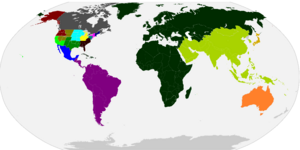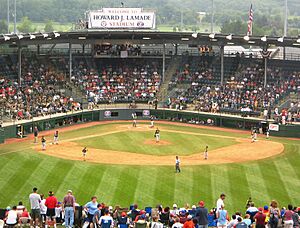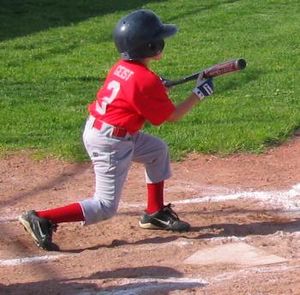Little League Baseball facts for kids
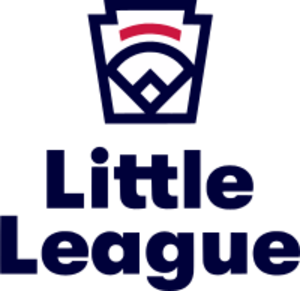 |
|
| Sport | Baseball, softball |
|---|---|
| Founded | 1939 in Williamsport, Pennsylvania, U.S. |
| Founder | Carl E. Stotz |
| Inaugural season | 1939 |
| CEO | Stephen D. Keener |
| COO | Patrick Wilson |
| Director | David Houseknecht, CFO |
| Claim to fame | Largest organized youth sports organization in the world |
| Motto | Character, Courage, and Loyalty |
| No. of teams | over 180,000 |
| Competitors | 2,600,000 |
| Qualification | Little League International Tournament |
| TV partner(s) | ESPN, ESPN2, ABC; Madison Square Garden Network (MSG), New England Sports Network (NESN) |
Little League Baseball and Softball is a special organization that helps kids and teens play baseball and softball. It's a non-profit group based in Pennsylvania, USA. Little League organizes local sports leagues for young people all over the United States and in many other countries.
Carl Edwin Stotz started Little League in 1939 with just three teams in Williamsport, Pennsylvania. The idea grew, and Little League became an official organization in 1950. Little League encourages grown-up volunteers to create and run local teams. These local leagues can set up their programs in the best way for the kids in their area. There are different divisions for children and teenagers from 4 to 16 years old. The United States Congress has even given Little League a special charter.
The main office for Little League is in South Williamsport, Pennsylvania. The very first Little League Baseball World Series was played in Williamsport in 1947. Today, the Little League International Complex in South Williamsport hosts the yearly Little League Baseball World Series at Howard J. Lamade Stadium and Little League Volunteer Stadium. It's also home to the Peter J. McGovern Little League Museum, where you can learn about the history of Little League Baseball and Softball through fun exhibits. Many famous players from Major League Baseball started their journey playing in their local Little League teams.
Contents
The Story of Little League Baseball
Little League Baseball was founded in 1939 by Carl Edwin Stotz. He lived in Williamsport, Pennsylvania. Carl started trying out his idea in the summer of 1938 with his nephews and their friends. They played informal games and tried different field sizes. By the next summer, they were ready to start Little League Baseball.
The first league in Williamsport had only three teams. Businesses sponsored these teams: Jumbo Pretzel, Lycoming Dairy, and Lundy Lumber Company. Carl Stotz and his friends, George and Bert Bebble, managed the teams. These men, along with their wives and another couple, formed the first Little League board of directors.
The first official game was on June 6, 1939. Lundy Lumber won against Lycoming Dairy, 23–8. Little League quickly grew. The next year, a second league started in Williamsport. Now, Little League is an international organization with teams in every U.S. state and over 80 countries.
Girls in Little League
Kathryn "Tubby" Johnston Massar was the first girl to play in a Little League baseball game in 1950. However, after that season, Little League decided that girls would not be allowed to play. From 1951 to 1973, only boys could play Little League baseball.
In 1974, things changed. A lawsuit was filed for Maria Pepe, and a court decided that Little League baseball had to let girls play. In December 1974, President Gerald Ford signed a law that officially opened Little League baseball to girls.
By 2008, almost 2.6 million boys and girls played in Little League Baseball worldwide. About 400,000 of these players were in softball leagues. Since 2022, Little League Baseball has been divided into 20 regions for tournaments: ten in the U.S. and ten international. Every summer, Little League hosts seven World Series tournaments in different places across the U.S.
Important Moments in Little League History
Early Years of Little League
- 1939: Carl E. Stotz and his friends start Little League. The first season is played near Bowman Field.
- 1946: Little League grows to 12 leagues, all in Pennsylvania.
- 1947: The first league outside Pennsylvania starts in New Jersey. The first Little League World Series is played, and a team from Williamsport wins.
- 1948: Little League has 94 leagues. A company called U.S. Rubber becomes the first sponsor, giving shoes to teams.
- 1949: Little League is featured in a famous magazine, Saturday Evening Post. People all over the country want to start their own leagues.
- 1950: Kay Johnston, also known as "Tubby," becomes the first girl to play Little League baseball. She pretends to be a boy to join a team. After one season, a new rule is made to stop girls from playing. This rule lasts until 1974.
- 1951: Leagues start in Canada and the Panama Canal Zone, making Little League international.
- 1953: The Little League World Series is shown on TV for the first time. Joey Jay becomes the first Little League player to play in Major League Baseball.
- 1955: Little League is in all 48 U.S. states. George W. Bush, who later became President, plays Little League.
- 1956: Carl Stotz leaves Little League Baseball Inc. because he feels it's becoming too focused on money.
Little League Goes Global
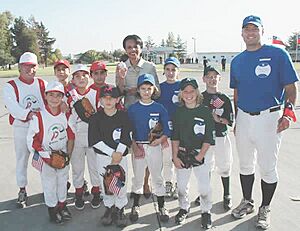
- 1957: A team from Monterrey, Mexico, is the first team from outside the U.S. to win the Little League World Series.
- 1959: The Little League World Series moves to the new Little League headquarters in South Williamsport. The protective baseball helmet is invented.
- 1960: A team from West Berlin, West Germany, is the first from Europe to play in the World Series.
- 1967: A team from West Tokyo, Japan, is the first from Asia to win the World Series.
- 1969: Taiwan begins a period of winning many Little League World Series titles.
- 1971: The aluminum baseball bat is first used.
- 1974: Girls are officially allowed to play in Little League. A Little League Softball program is also created for both boys and girls.
- 1975: For one year, foreign teams are not allowed in the Little League World Series, but international play returns the next year.
- 1982: The Peter J. McGovern Little League Museum opens.
- 1984: A team from Seoul, South Korea, wins their nation's first title. Victoria Roche from Belgium becomes the first girl to play in the Little League World Series.
- 1989: Poland becomes the first country from the former Warsaw Pact to have a Little League team.
- 1992: Carl Stotz, the founder, passes away. Lights are installed at Lamade Stadium, allowing night games.
- 1993: Long Beach, California, becomes the first U.S. team to win two years in a row.
- 1999: Burkina Faso becomes the 100th country with a Little League organization.
- 2001: The Little League World Series expands from 8 to 16 teams. George W. Bush becomes the first U.S. president to visit the World Series.
- 2012: A team from Uganda is the first from Africa to play in the Little League World Series. Australia gets its own spot in the World Series. A new division, the Intermediate (50/70) Division, is officially added.
- 2013: Davie Jane Gilmour becomes the first woman to lead the Little League board of directors. The first Intermediate Little League World Series is held.
- 2014: Mo'ne Davis becomes the first girl in Little League World Series history to win a game as a pitcher and pitch a shutout. She is also the first Little Leaguer to be on the cover of Sports Illustrated.
- 2020: The Little League World Series is canceled due to the COVID-19 pandemic.
- 2021: The World Series is played with only U.S. teams because of the pandemic.
- 2022: The World Series returns to normal with 20 teams, adding new regions.
Little League Regions
For the 2022 tournament and beyond, Little League Baseball World Series teams come from these regions:
- U.S. Regions:
* Great Lakes * Metro * Mid-Atlantic * Midwest * Mountain * New England * Northwest (including Alaska) * Southeast * Southwest * West (including Hawaii)
- International Regions:
* Canada * Mexico * Asia-Pacific * Japan * Europe and Africa * Australia * Latin America * Caribbean * Cuba, Panama, and Puerto Rico (two of these three teams get a direct spot each year, while the third plays through its normal region)
Little League World Series Events
The most famous event in Little League is the yearly Little League Baseball World Series. It happens every August in South Williamsport, Pennsylvania. Teams play in local and regional tournaments all over the world to earn a spot in the World Series.
Other Little League World Series Events
The Little League Baseball World Series is just one of nine World Series tournaments that Little League International holds each year. They are held in different places:
- Little League World Series (baseball)
- Intermediate Little League World Series (baseball)
- Junior League World Series (baseball)
- Senior League World Series (baseball)
- Girls Little League Softball World Series
- Girls Junior League Softball World Series
- Girls Senior League Softball World Series
Little League Museum
The Peter J. McGovern Little League Museum is a place where you can learn all about the history of Little League Baseball and Softball. It has interactive exhibits that are fun for kids.
Awards in Little League
Little League gives out several awards to recognize great sportsmanship and dedication:
- Good Sport of the Year Award
- Challenger Award
- Bill Shea Distinguished Little League Graduate Award
- George and Barbara Bush Little League Parents of the Year Award
- Volunteer of the Year Award
- Howard Hartman Little League Friendship Award
Baseball Divisions
Little League Baseball has different divisions based on the age of the players.
Main Baseball Divisions and Their World Series
| Division | Location | First held | Age of players | Series |
|---|---|---|---|---|
| Little League Baseball | South Williamsport, Pennsylvania | 1947 | 9–12 years old | Little League World Series |
| Intermediate League Baseball | Livermore, California | 2013 | 11–13 years old | Intermediate League World Series |
| Junior League Baseball | Taylor, Michigan | 1981 | 13–14 years old | Junior League World Series |
| Senior League Baseball | Easley, South Carolina | 1961 | 14–16 years old | Senior League World Series |
Tee-ball Division
Tee-ball is for boys and girls aged 4–7. In tee-ball, players hit the ball from a tee, not from a pitcher. This division teaches young children the basic skills of hitting and fielding.
Minor League Division
The Minor League baseball division is usually for children aged 5–11. Local leagues can divide this division further based on age or experience. At lower levels, a coach or a machine pitches the ball. At higher levels, players pitch.
Little League (Major Division)
The Little League Baseball division, also called the Major Division, is for children aged 9 to 12. The baseball field has bases 60 feet apart and the pitcher's mound is 46 feet from home plate. Local leagues can form "All Stars" teams from their best players. These teams can enter an international tournament that ends with the Little League World Series.
Intermediate (50/70) Division
This division started in 2013 and is for players aged 11–13. The field is bigger than in the Major Division, with bases 70 feet apart and the pitcher's mound 50 feet from home plate. In this division, players can lead off and steal bases, just like in regular baseball. Little League holds an Intermediate League World Series for this division in Livermore, California.
Junior and Senior Leagues
The Junior League and Senior League divisions use a standard-sized baseball field, like those used by professional players. The bases are 90 feet apart, and the pitcher's mound is 60.5 feet from home plate.
- The Junior League is for 12–14 year olds.
- The Senior League is for 13–16 year olds.
Like the Major Division, local leagues can form "All Stars" teams for these age groups to compete in their own "World Series" tournaments.
Challenger Program
Little League started the Challenger Division in 1989. This program gives children with physical and intellectual challenges a chance to play Little League. In the Challenger Division, players have "buddies" (other Little Leaguers) who help them with batting, running, and fielding. Challenger Division games are usually just for fun, not for competition.
Little League Challenger Division
This division is for players aged 4–18. Games are played on a smaller field and are non-competitive.
Senior League Challenger Division
This division started in 2015 and is for players aged 15 and older (no maximum age). Games are played on a standard-sized field and are also non-competitive.
Participation in Challenger Program
As of 2018, almost 1,000 Little Leagues in 10 countries offer the Challenger Program. This means more than 31,000 people with physical or intellectual challenges can enjoy playing Little League.
Softball Divisions
Little League Baseball also has several softball divisions for girls and boys, based on age.
| Division | Location | First Held | Age of players | Series |
|---|---|---|---|---|
| Little League Softball | Greenville, North Carolina | 1974 | 9–12 years old | Little League World Series (softball) |
| Junior League Softball | Kirkland, Washington | 1999 | 12–14 years old | Junior League World Series (softball) |
| Senior League Softball | Sussex County, Delaware | 1976 | 13–16 years old | Senior League World Series (softball) |
Girls Softball Divisions
- Girls Tee Ball Softball
- Girls Minor League Softball
- Girls Little League Softball (Major Division)
- Girls Junior League Softball
- Girls Senior League Softball
Little League Rules
The rules for Little League baseball are mostly like the official baseball rules used by Major League Baseball. However, there are some important differences, especially for younger divisions.
Game Length
A regular game for Little League (ages 7–12) has six innings. If a game stops early, it's official if at least four innings are completed.
For Intermediate, Junior, and Senior League levels (ages 13–18), a game has seven innings. It's official if five innings are completed.
Mandatory Play Rule
In most divisions, every player on the team must get to bat at least once and play six outs (two innings) in the field during each game. This rule helps make sure everyone gets to play.
Playing Field Sizes
The size of the field changes depending on the division:
- Tee-ball: Bases are usually 50 feet apart.
- Minor League and Little League: Bases are 60 feet apart. The pitcher's mound is 46 feet from home plate. Outfield fences are usually 200 feet or more away.
- Intermediate Little League: Bases are 70 feet apart. The pitcher's mound is 50 feet from home plate.
- Junior League and Senior League: These divisions use a full-sized baseball field. Bases are 90 feet apart, and the pitcher's mound is 60.5 feet from home plate, just like in Major League Baseball.
Equipment Rules
- Bats: Bats can be made of wood or other materials like aluminum. They must be approved for Little League. For younger divisions (Majors and below), bats have limits on length and barrel size.
- Helmets: Protective batting helmets are very important for safety.
Base Running Rules
- In Minor League and standard Little League, a runner cannot leave the base until the pitcher throws the ball and it reaches the batter.
- In older divisions (Intermediate, Junior, Senior), runners can leave the base at any time once the ball is in play.
- Runners must try to avoid contact with fielders who are waiting at a base with the ball.
Batting Rules
- The strike zone goes up to the batter's armpits.
- In Tee-ball and Minor League, if a batter gets three strikes, they are out, even if the catcher drops the ball. In older divisions, a batter might be able to run to first base on a dropped third strike if certain conditions are met.
- If a pitcher hits a batter with the ball, the batter usually gets to go to first base. However, if the batter didn't try to get out of the way, the umpire might not give them the base.
Pitching Rules
Pitchers in all divisions have limits on how many pitches they can throw in a game. They also need to rest for a certain number of days between games. These limits depend on the pitcher's age. If a pitcher hits too many batters or intentionally hits a batter, they might have to stop pitching in that game.



